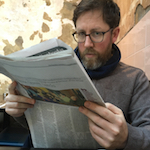The Eden Project: anything’s possible with the right vision
Sir Tim Smit, co-founder of Cornwall’s Eden Project, explains how a galvanising message can hold a team together through the toughest of projects.
Nestled into a sterile old china-clay pit outside the neglected town of St Austell, the Eden Project draws around a million visitors a year. They come not just for the innovative architecture and exotic flora, but also for the art and sculpture, restaurants and education centres, and a gig programme that has hosted Pulp, PJ Harvey, the Kaiser Chiefs and Kylie Minogue. So how did it all come to pass?
Well, this fertile mix bloomed from the mind of Sir Tim Smit. Of course, this was not Smit’s first horticultural project. Having built a successful career in the music business, writing hits and producing for Barry Manilow, Alvin Stardust and Twiggy, Smit had moved to Cornwall and found a lost world of his own. One February day in 1990, there he was, machete in hand, hacking through “laurels as thick as a man’s thigh” on an overgrown old estate a friend had inherited.
It was this “piratical” process of restoring the Lost Gardens of Heligan over the course of six years that proved to Smit the power of storytelling as a means of building a team and bringing other people into his vision. “If the project is an orchestra, the skill of the conductor is to create a narrative in which everybody who participates can be a star of some kind,” he says.
Putting it into practice
Construction on the Eden Project began in 1998. Here was that ethos writ large: a project to prove that, if enough people buy into the dream, they can pull off the remarkable – transforming a site left for dead into a living celebration of our interdependence with nature.
The clay pit had its challenges: the base sat 15 metres below the water table and had no soil. They had 134 consecutive days of rain, which required pumping out. Twelve dumper trucks and eight bulldozers shifted 1.8 million tonnes of ground material – without taking any of it off-site. Building the biomes took 230 miles of scaffolding. Eden’s biggest feature, the Rainforest biome, is 100 metres high, 200 metres long and 50 metres wide, but it weighs next to nothing, because its honeycomb panels are made of ETFE – a light, recyclable plastic that transmits sunlight. It was built as a complete bubble, and then cut to a dome where it met the uneven ground.
Tracking progress
Of course, you won’t manage any of that simply by telling a good story. Crucially, Smit has the gift of corralling the right minds too. Early on, project manager Tim Carter insisted they create a diary marking the next two-and-a-half years, and that they fill in every meeting they’d need in that time. If Smit or his team missed any, he stressed, Eden wouldn’t get built.
“He meant that you’ve got to have a structure that is constantly measuring and testing progress,” Smit explains. “That’s a tremendous art. I may strain against constraints, but I would never fight that now. I’ve seen great process management and it’s fantastic. It makes people safe, enables people to know what they’re doing and enables you to pick up on any approaches that aren’t right. Otherwise behaviours become enshrined, and you want to guard against that.”
Building the future
Getting a team of project managers to buy into a grand vision isn’t always easy though. Project management, Smit says, needs “glamming up”. “If you want to attract the brightest and best to become project managers, you’ve got to make it clear that we’re the enablers who are shaping the future of the world,” he says.
“There’s a space for the creative, the informed, the emotionally intelligent project manager. In my experience, women are very good at this role, and there are certain elegant attributes that women bring to problem-solving. We need to attract more women into the profession.”
Ultimately, the Eden Project achieved what so few high-profile UK projects seem able to: it came in on time, on budget, with no litigation. It almost makes it look easy.
This story originally appeared in the spring issue of Project journal. Read the full article The big interview: Sir Tim Smit or Download the latest digital issue now.
You may also be interested in
What is project team management and leadership?
Project leadership: skills, behaviours, knowledge and values
Brought to you by Project journal


0 comments
Log in to post a comment, or create an account if you don't have one already.